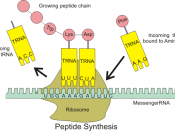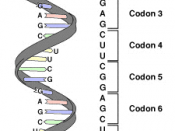The process of protein synthesis is vital in organisms, and the release of different types of polypeptides from ribosomes all over the body links genotype to phenotype in the resulting organism. The individual types of RNA (ribonucleic acid) each play their own very important role in going from DNA coding to the final release of a protein chain. Translation itself is the process that makes the distinct change from the information in the nucleic acids to those in amino acids. In essence, the hereditary instructions for building proteins are encoded in the nucleotide sequence of DNA and messenger-RNA. These, in turn, create the genetic code and the extreme relation between a cell's beginning nucleic acid transforming in to a developed protein.
This entire process of protein synthesis begins with the attachment of messenger RNA to the small subunit of a ribosome that consists of a ribosomal-RNA molecule and a number of different proteins.
The large subunit, in contrast, consists of two different rRNA-molecules and different proteins that are responsible for linking together the amino acids being delivered to the ribosome by tranfer-RNA molecules. The translation of a messenger-RNA transcript produces a polypeptide chain in the three stages of initiation, elongation, and termination. First, a special initiator t-RNA molecule binds to a P-site on the small ribosomal subunit and the m-RNA moves along the subunit until its start codon, or specific sequence of three nucleotide bases, arrives at the P-site. Chain elongation begins once the codon finds and base pairs with its corresponding anticodon on the t-RNA. The large subunit of the ribosome is now able to bind to the small unit, making a "complex" that allows for the elongation of the chain. Start codons on the m-RNA determine the reading frame for assembling amino acids in a sequence...


